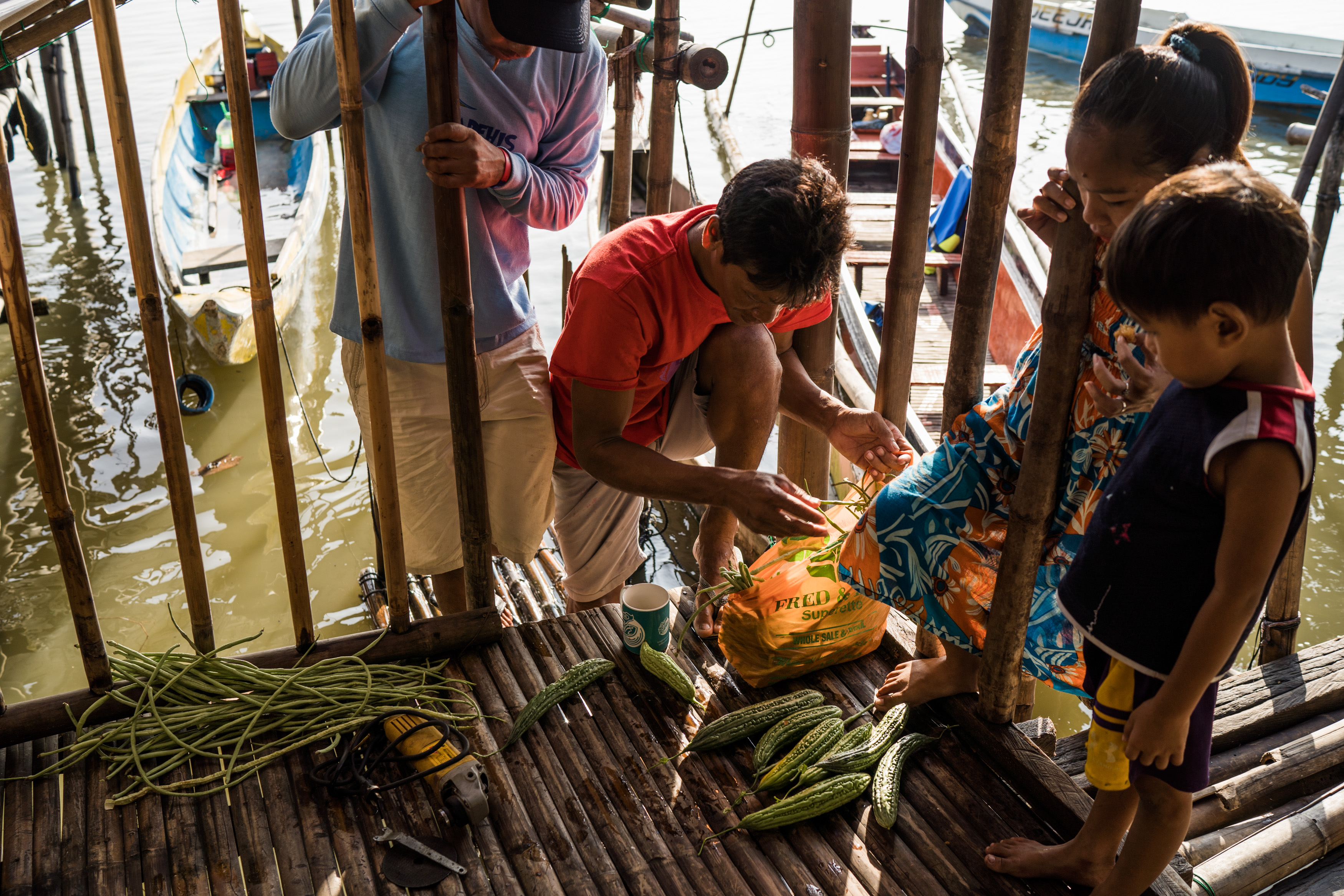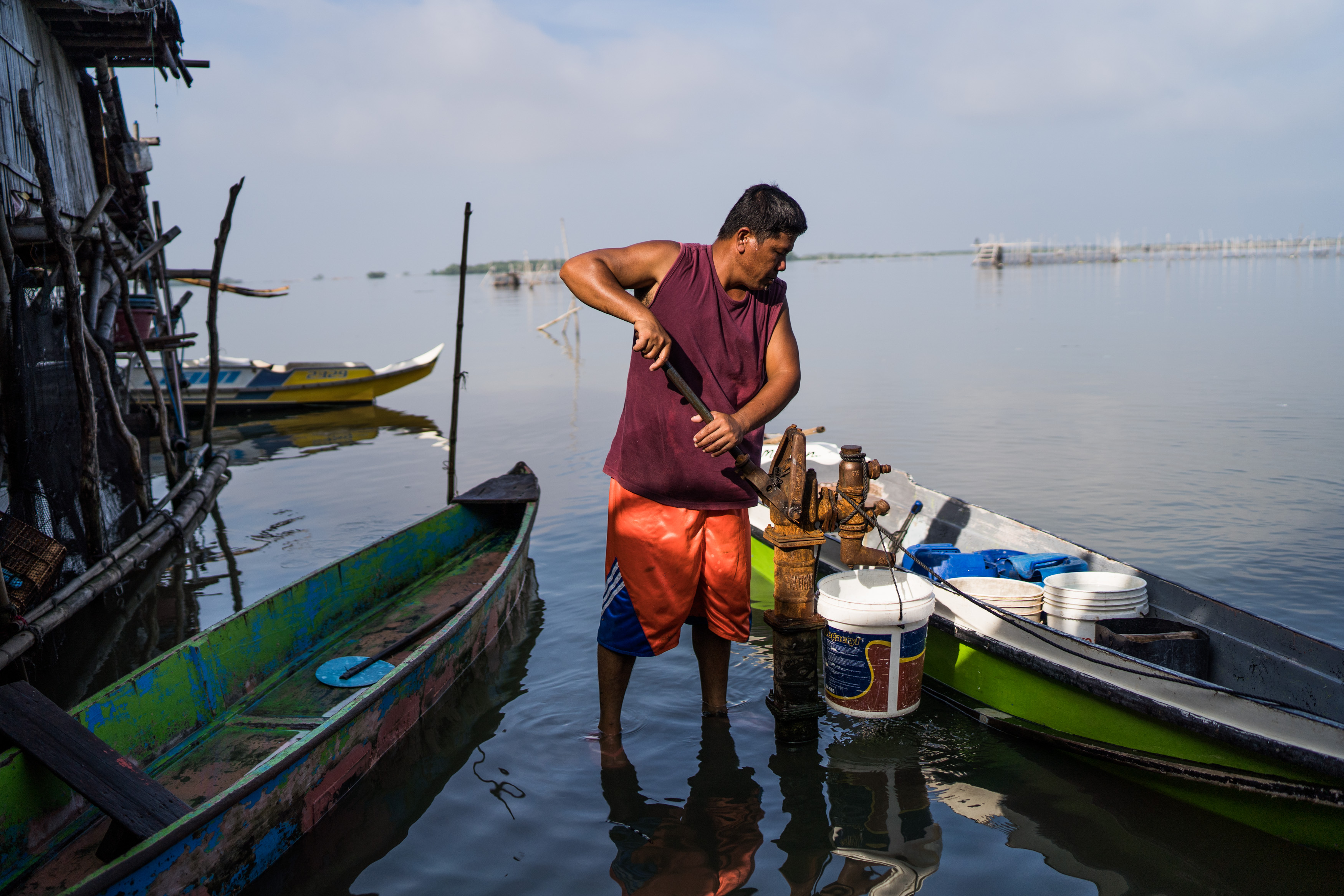This article is part of a wider initiative by VICE looking at the state of the environment around the globe. In Asia-Pacific, each VICE office is examining the main concerns from their territory, in an effort to gauge the health of the planet as a whole and to highlight the widespread need for change. For other stories in this series, please check out Environmental Extremes.
Standing on the deck behind her parent’s house one early morning in August, Mary Anne Anzueres, 32, recalled precious moments from her childhood. Like how she and her siblings biked around the neighborhood and walked down a rocky pathway that connected the chapel, school, and community basketball court.
Videos by VICE
“There were lots of trees, trees everywhere, big trees,” she said with a hint of nostalgia while looking out to a vast space of open water. One step forward, and she would’ve plunged right into the river that had, in the last 6 years at least, come to encroach her family home.
Mary Anne is from Sitio Pariahan in Bulakan, Bulacan, a coastal village about 30 kilometres north of Manila that is now partially submerged in water. The chapel, school, and basketball court Mary Anne used to frequent are now in ruins, only accessible by boat. Her childhood home stands on bamboo stilts. That morning, the water was waist-deep.
Locals say the flooding started after 2011’s Typhoon Nesat, which devastated the area and destroyed dikes that kept water out, but according to experts, the problem lies beneath the surface.
It’s called land subsidence, or the sinking of land due to the over extraction of groundwater through deep wells. Most provinces outside Metro Manila rely on these wells for fresh water. Even water providers in rural towns like Bulakan, source from underground before distributing to homes through pipes.

Mahar Lagmay, professor and executive director of the University of the Philippines Resilience Institute, explained to VICE that land naturally subsides when underground sediments compact but it is usually replaced by new material in time. But in Pariahan, the sinking is just too fast.
According to Lagmay’s satellite monitoring, the village and nearby areas are subsiding by up to 4 to 5 cm a year, which results in the flooding. This aggravates the effects of global warming, which raises sea levels in the area by about 3 to 5 mm a year.
“If they’re extracting groundwater at an extremely fast rate and it’s irreversible, then it’s destructive, right?” Lagmay said. “You want it to go back to its original state.”
The same thing is happening in cities around the world including Jakarta, Beijing, and Houston. In the Philippines, the phenomenon is occurring in various areas including some in northern Metro Manila but it is most evident in old coastal villages like Pariahan where structures have sunk with the land they were built on.
“The problem is, it’s closer to the coast so, therefore, if it sinks, it’s more vulnerable to incursion of water, especially during high tide,” Lagmay said.
Pariahan residents say there used to be about a hundred houses in the area but now the number is down to around 40, after families were forced out to the inland by the near-apocalyptic environment.
This includes Mary Anne, a housewife and former factory worker, who now lives in the nearby village Sta. Ines with her husband and two sons. They left because her husband remains traumatised by the big waves Typhoon Nesat brought to the area that pushed them out of their boat and forced them to hold on to bamboo poles anchored on the river bed.
Pariahan still holds a special place in her heart, so she frequently visits her parents and two siblings whose home has become the de-facto public square.

The journey to Pariahan from Bulakan’s town centre takes about 30 minutes by boat. It could have been scenic, if it weren’t for the abandoned concrete houses, now flooded, that welcome you. Homes of the remaining families are connected by makeshift bamboo bridges and residents ride boats to go to other clusters of shacks.
The community gathers in Mary Anne’s family home daily. Children crowd around smartphones with the latest addicting app, while adults gamble and play cards. They sit on benches that hide fighting cocks underneath.
Mary Anne’s mother Benny Espiritu was born in Pariahan and refuses to leave the village. “This is where we grew up. Our children, my husband, their job is here,” Benny, 53, told VICE. She’s comfortable here and boasted about mastering the rise and fall of the water.
Most men in Pariahan are fisherfolk and have used the water’s predictable movements to their advantage. When the water is high, those brave enough dive down to nests, where crabs hide and grab them with their hands — a practice known as kapa, which literally means “to feel out.” Those who prefer a more passive source of income get up early in the morning to set up nets called dragon bubo underwater that trap fish, crabs, and shrimps brought by the current. Some earn up to PHP20,000 ($385.60 US) a week just by selling catch in the public market. Residents say that business has been booming since the water rose.
“Work now is so easy,” Jerick Manalaysay, 21 years old, said. “Unlike before. We would wait for fish ponds to dry up. We would kapa. Sometimes you won’t even catch anything.”
Despite the flooding, they wouldn’t trade it for living inland, where the only jobs available for non-college graduates are in construction sites or factories that pay the minimum wage of around PHP500 ($9.64 US) per day. Up there, they also need to buy food and can’t rely on the day’s catch.
“[In Pariahan] as long as you have rice, coffee, and sugar, you’re OK,” Benny said. Her son Randy Espiritu, 29 years old, thinks the same. “That’s why we don’t want to leave even if our village is submerged. Because here, just set up a fish trap and you’ll surely have money, food,” he said.

So instead of leaving, they adapt. They raise their houses to avoid the water, bring their children to school in boats, and hear mass with their feet submerged when they pool enough money to bring a priest to their chapel once a month.
But it won’t be as easy for other communities to adjust, especially those inland who will eventually experience flooding, too, if the problem of land subsidence is not addressed.
Groundwater comes from a layer of permeable rocks called aquifers, where rain seeps through. Extracting water from the ground leaves spaces between these sediments, collapsing the layer, and lowering the ground. It’s like a sponge that shrinks when water is squeezed out.
Most parts of the Philippines depend on deep wells because it is the most accessible and affordable source of freshwater, Sevillo D. David, Jr., executive director of the National Water Resources Board (NWRB) told VICE. This is especially true for areas that don’t have access to surface water like rivers and lakes. Groundwater is also relatively clean and requires minimal treatment.
This dependence could be destructive to the environment. Excessive groundwater extraction is caused by a combination of factors, such as an increase in demand from residents.

“The increase in demand for water does not stop because population is growing, development is increasing, urbanisation is rising,” David said.
The United Nations Population Fund reported in April that the Philippines had an annual population growth rate of 1.6 percent from 2010 to 2019, among the highest in Southeast Asia and faster than India’s which was recorded at 1.2 percent. Because of its close proximity to Manila, Bulacan is one of the most rapidly urbanising provinces in the Philippines.
The NWRB does not require permits for deep wells meant for “personal use,” which it defines as a household of five people. In reality though, most families are larger than this. Most Pariahan residents are relatives who live in interconnected homes and share one deep well behind Benny’s home because water providers don’t reach the area.
Even houses in rural areas that are connected to water providers get their water from the ground. While Bulakan is part of the Bulacan Bulk Water Supply project and will soon be connected to surface water, the town is still mostly serviced by the Bulakan Water Company, a partnership between the government-owned Bulacan Water District and the private Manila Water Company, which still pumps water from the ground.
But rapid population growth is not the only cause of the problem. Industrial factories and fishponds are also some of the biggest extractors of groundwater, and there are many of them near Bulakan.
Through their satellite monitoring, Lagmay found that areas with high rates of land subsidence are also sites of large industrial factories. Pariahan is close to the towns of Obando, Valenzuela, and Malabon which are home to factories for plastic, food manufacturing, and textiles among others.
“Remember, if they’re factories, they have money. When they have money, they can buy pumps,” he said. “The property is fenced, it’s not easy to monitor that; it’s private.”
The NWRB requires municipal, agricultural, industrial, and commercial projects to apply for water permits before drilling new deep wells. These applications go through a field investigation and evaluation among other steps before approval.
David, the board’s director, said they started to closely monitor groundwater extraction in select areas about five years ago. In the new method, they determine a “safe yield” for the amount of water that can be extracted from a certain area and check quarterly to see if these sites stay within the limit. However, they cannot stop the use of deep wells without providing an alternative source first.
Lagmay acknowledged that there has been a slight improvement in land subsidence rates — which used to be at 5 to 6 cm — but does not think this is enough.
“We need to address it better because 4 to 5 [cm]… is still worrisome,” he said.

Both David and Lagmay said that the best way to stop excessive groundwater extraction is to connect more communities to surface water. This would entail creating new dams or connecting them to existing ones. Because of the abundance of seawater, desalination is another option, which David said is already present in some communities in Cebu. But because of financial, political, and environmental constraints, these solutions have not been implemented in most areas.
In the meantime, they’ve closed illegal deep wells and limited the issuance of water permits in various areas including parts of northern Metro Manila like Navotas and Caloocan that were found to be in critical condition – places that could soon face Pariahan’s flooding fate too.
The consequences could be bleak.
In Pariahan, if the land continues to subside at present rates, it could sink by up to half a metre in 10 years or 5 metres in 100 years. This means the encroachment of salt water underneath the ground and water going beyond coastal areas and into inland communities. These changes could affect an area’s biodiversity and landscape — water will be contaminated, rice won’t grow, and swamp lands for migratory birds will be underwater.
“Continued subsidence will sink those former land areas,” Lagmay said. “Sink them and become an underwater world.”





